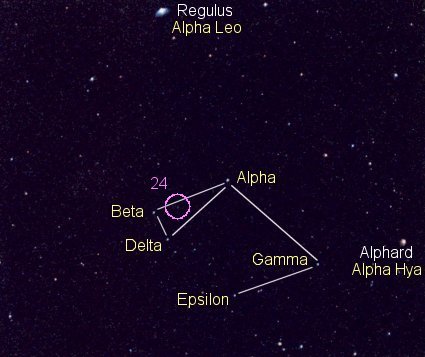 A cool evolved star, 24 Sextantis has not one, but two Jupiter-like
planets in relatively wide resonant orbits that almost touch each
other.
A cool evolved star, 24 Sextantis has not one, but two Jupiter-like
planets in relatively wide resonant orbits that almost touch each
other.
THE PLANETS
The circle shows the location of the evolved class K star 24
Sextantis (in Sextans, the Sextant),
about which orbit two planets. The inner, with a mass of at least
twice that of Jupiter, takes 1.24 years to make a circuit at an
average distance of 1.33 Astronomical Units, a relatively low
eccentricity of nine percent taking 24 Sextantis "b" between 1.21
and 1.45 AU from its star. The outer one, 24 Sextantis c, is
smaller, with a minimum mass of 0.86 Jupiters, though in a larger
orbit with an average radius of 2.08 AU. Two matters then grab
further attention. The outer planet has a notably larger
eccentricity of 0.29 that moves it as far as 2.68 AU from the star
to as close as 1.47 AU. That is, the "apastron" (farthest point in
orbit) of 24 Sextantis b almost overlaps with the "periastron"
(closest point) of 24 Sextantis c. They are also almost certainly
in "resonance" with each other, with the orbits locked at a two-to-
one ratio of the periods, which, along with orbital orientation,
keep them from crashing into each other. (While the measured ratio
of the periods is 1.95, the uncertainties easily allow an exact
factor of two.) Such larger planets should have formed farther out
where it is colder and they could accumulate their large masses by
accreting volatile hydrogen, helium, and water from the primitive
circumstellar disk. They, like the great number of close-in
"Jupiters," have almost certainly migrated inward through
gravitational influences and interactions with the leftover disk,
in this case until they became trapped into their resonance.
|
 A cool evolved star, 24 Sextantis has not one, but two Jupiter-like
planets in relatively wide resonant orbits that almost touch each
other.
A cool evolved star, 24 Sextantis has not one, but two Jupiter-like
planets in relatively wide resonant orbits that almost touch each
other.
 A cool evolved star, 24 Sextantis has not one, but two Jupiter-like
planets in relatively wide resonant orbits that almost touch each
other.
A cool evolved star, 24 Sextantis has not one, but two Jupiter-like
planets in relatively wide resonant orbits that almost touch each
other.